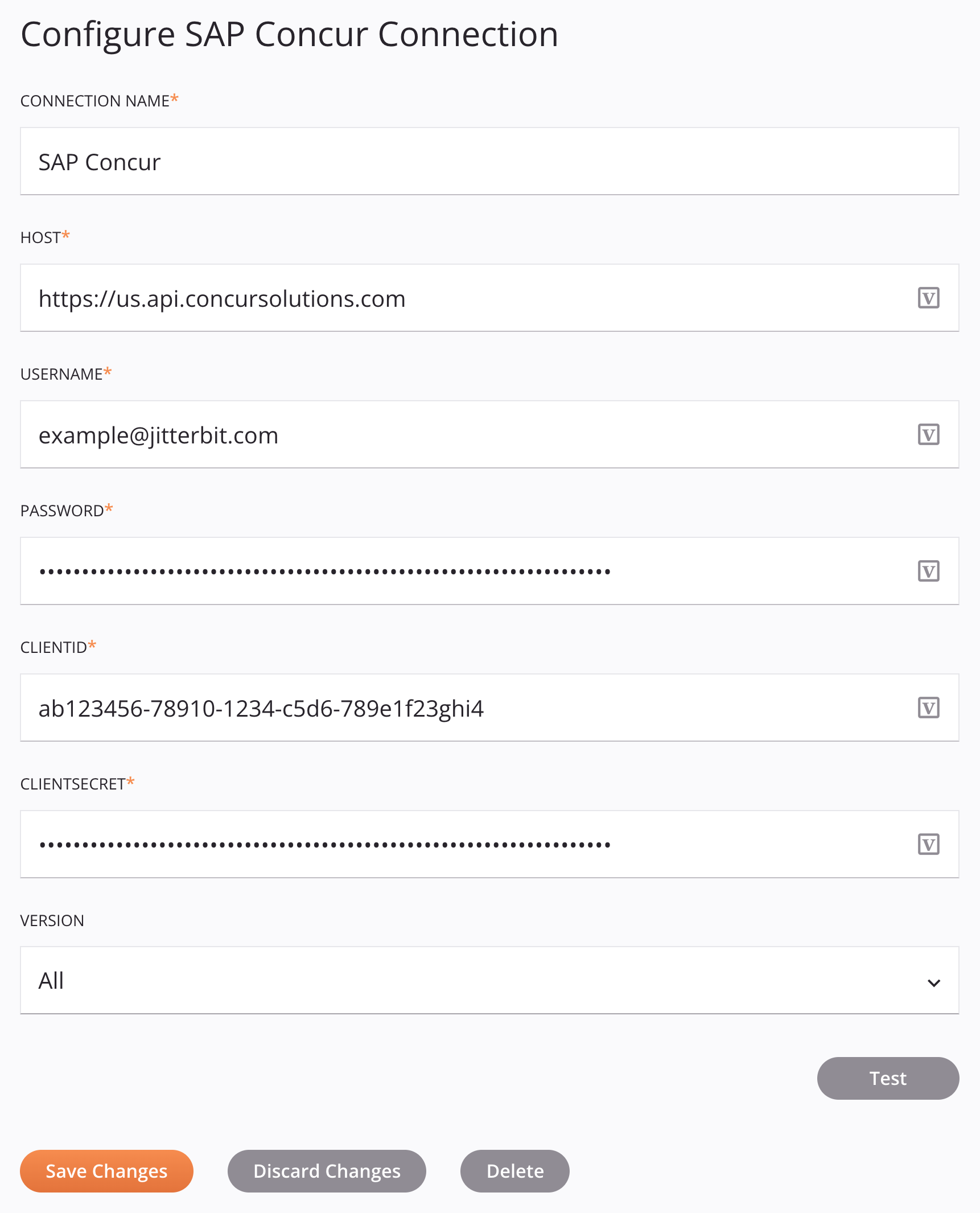SAP Concur connection¶
Introduction¶
An SAP Concur connection, created using the SAP Concur connector, establishes access to SAP Concur. Once a connection is configured, you can create instances of SAP Concur activities associated with that connection to be used either as sources (to provide data in an operation) or as targets (to consume data in an operation).
Note
This connector supports the Enable Re-authentication on Change organization policy. If enabled, a change to the Host, Username, or Client ID in this connection requires users to re-enter the Password and Client Secret for the connection.
Create or edit an SAP Concur connection¶
A new SAP Concur connection is created using the SAP Concur connector from one of these locations:
- The design component palette's Project endpoints and connectors tab (see Design component palette).
- The Global Connections page (see Create a global endpoint in Global Connections).
An existing SAP Concur connection can be edited from these locations:
- The design component palette's Project endpoints and connectors tab (see Design component palette).
- The project pane's Components tab (see Component actions menu in Project pane Components tab).
- The Global Connections page (see Edit a global endpoint in Global Connections).
Configure an SAP Concur connection¶
Each user interface element of the SAP Concur connection configuration screen is described below.

Tip
Fields with a variable icon support using global variables, project variables, and Jitterbit variables. Begin either by typing an open square bracket [ into the field or by clicking the variable icon to display a list of the existing variables to choose from.
-
Connection name: Enter a name to use to identify the connection. The name must be unique for each SAP Concur connection and must not contain forward slashes
/or colons:. This name is also used to identify the SAP Concur endpoint, which refers to both a specific connection and its activities. -
Host: Enter the hostname for the connector in the format of
https://{servername}, such ashttps://us.api.concursolutions.com. -
Username: Enter the username for the instance.
-
Password: Enter the password.
-
Client ID: Enter the client ID. For more information, see SAP Concur's connectivity documentation (login required).
-
Client secret: Enter the client secret. For more information, see SAP Concur's connectivity documentation (login required).
-
Version: Select the SAP Concur REST API version, one of All, v3.0, v3.1, v3.2, or v4.0.
Note
The Vendors object is supported only for v3.0.
-
Test: Click to verify the connection using the specified configuration. When the connection is tested, the latest version of the connector is downloaded by the agent(s) in the agent group associated with the current environment. This connector supports suspending the download of the latest connector version by using the Disable Auto Connector Update organization policy.
-
Save Changes: Click to save and close the connection configuration.
-
Discard Changes: After making changes to a new or existing configuration, click to close the configuration without saving. A message asks you to confirm that you want to discard changes.
-
Delete: After opening an existing connection configuration, click to permanently delete the connection from the project and close the configuration (see Component dependencies, deletion, and removal). A message asks you to confirm that you want to delete the connection.
Next steps¶
After an SAP Concur connection has been created, you place an activity type on the design canvas to create activity instances to be used either as sources (to provide data in an operation) or as targets (to consume data in an operation).
Menu actions for a connection and its activity types are accessible from the project pane and design component palette. For details, see Actions Menus in Connector Basics.
These activity types are available:
-
Read: Retrieves all object data from SAP Concur and is intended to be used as a source in an operation.
-
Query: Queries specified object data from SAP Concur and is intended to be used as a source in an operation.
-
Create: Creates object data in SAP Concur and is intended to be used as a target in an operation.
-
Update: Updates object data in SAP Concur and is intended to be used as a target in an operation.
-
Delete: Deletes object data from SAP Concur and is intended to be used as a target in an operation.